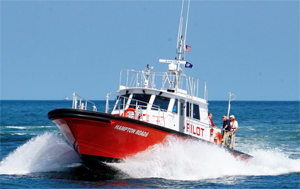Pilot boats with sleek deep-V hulls have been the industry standard for nearly 40 years, the result of collaboration between two American shipbuilding icons. But the partnership that spawned this groundbreaking design might never have happened without input from a Delaware Pilot named Jim Adams.
Adams, who died in 2012 at age 70, approached Gladding-Hearn Shipbuilding in the mid-1970s with an unusual idea for the association’s next pilot boat: Why not design it like some of the zippy powerboats he saw darting through Delaware Bay?
Preston Gladding called C. Raymond Hunt at Adams’ request, and the two designers ultimately collaborated on the first deep-V pilot boat. In an era where 10 knots was considered fast, the steel-hulled Delaware, delivered in 1979, could touch 20.
“In those days, that was a big deal,” said Winn Willard, president of Ray Hunt Design of New Bedford, Mass. “Other pilots took notice. Next came Tampa and then Great Lakes, with two more steel boats, and then Virginia and Charleston came along and wanted aluminum boats that could go faster yet.”
Pilot boats serve a single, critical function. They must transport pilots to and from ships during all weather and sea states. Speed is important, but the stability and safety alongside the ship is paramount.
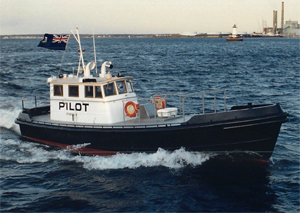 |
|
The 50-foot steel pilot cutter St. George, designed by Preston Gladding, predated the deep-V hull pilot boats that became the industry standard starting in 1979. |
|
Courtesy Gladding-Hearn Shipbuilding |
“If it doesn’t go alongside the ship and get away from the ship safely, nothing else matters, it’s not a pilot boat,” said Peter Duclos, the second-generation president of Gladding-Hearn, which has built 89 pilot boats since opening in 1955.
Pilot associations tend to be conservative and risk-averse. For a century, pilots lived aboard station ships in the harbor and rowed in dories to and from ships. The Boston Harbor Pilot Association schooner Roseway was the last pilot schooner operating when it ended service in 1973.
Tradition-bound pilot groups were forced to adapt to a new model as shoreside operations became the norm. The desire for faster pilot boats was thus borne from necessity. Coming ashore meant pilots had to cover more distance between their home base and the ships calling on the harbor.
Modern pilot boats are loaded with innovative technology, from powerful engines to advanced wheelhouse electronics to shock-mitigating seats designed to reduce fatigue. Launches capable of 25 knots are now standard, as are components designed for improved trim and ride control.
These noteworthy advances make good pilot boats faster, safer and more efficient. But they also represent incremental steps rather than the radical change brought about in the 1970s with the adaptation of the deep-V hull to the commercial market.
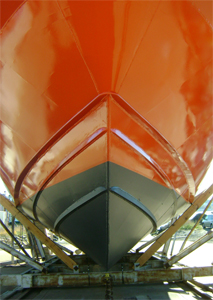 |
|
C. Raymond Hunt developed the deep-V design in the 1950s and 1960s. The V-shape runs from the bow to the transom and cushions the vessel against the water. |
|
Courtesy Gladding-Hearn Shipbuilding |
“The concept of the deep-V has not changed, but the details of how we apply it has evolved,” Duclos said in a recent interview. In other words, the benefits of the hull form have remained constant even as boats became bigger and more powerful.
C. Raymond Hunt developed the deep-V hull in the 1950s and ’60s. He is perhaps best known for incorporating the design into the Bertram 31 powerboat that still maintains a cult following. The key innovation was a high deadrise and V-shaped hull running from bow to stern. A deep-V vessel can maintain speed even in rough water, with the hull form cushioning the boat as it lands. Prior to Hunt’s design, fast flat-bottomed boats tended to “pancake” against the water.
Gladding-Hearn’s first pilot boat delivery was the 48-foot Brandywine in 1957 for the Delaware Pilots, formally known as The Pilots’ Association for the Bay & River Delaware. Designed by Preston Gladding, the launch was traditional, rugged and reliable and could make 10 knots.
“What made the small, steel pilot boats possible was the advent of large extruded rubber sections, which is really something that came out of World War II,” Duclos said, referring to fendering that prevented steel-on-steel contact between ships and pilot launches.
Gladding-Hearn and other builders churned out steel-hulled pilot boats for the next two decades. The engines and electronics changed, but the hulls remained more or less the same. In the mid-1970s, Adams helped steer Gladding-Hearn and the rest of the pilot industry into the modern era.
At about this time, the Delaware Pilots approached the shipyard about building a launch that could outpace Overfalls, a 16-knot, Gladding-built pilot boat delivered in 1971. Adams was familiar with Ray Hunt’s deep-V design and thought it might work for a pilot boat. He was right.
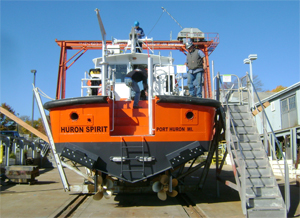 |
|
The deep-V Huron Spirit, built in 2016 by Gladding-Hearn, also has Humphree interceptors installed on the transom. |
|
Courtesy Gladding-Hearn Shipbuilding |
“(Delaware) proved to be an excellent pilot boat in the sense that it was stable along the ship,” Willard said. “Early deep-Vs had a reputation for rocking and rolling, and that was largely because they were designed with the chine out of the water so they could go fast.”
The new pilot boat was designed with the chine in the water, “so it has a big water plane, and that is how you get stability,” he said. “That is the same whether it’s a barge or a deep-V — the wider you make it, the more stable it is.”
The next big advance in pilot boat design came just a year later. Gladding-Hearn built its first aluminum deep-Vs, the 55-foot Carolina and Palmetto State, a few months apart in 1980 for the Charleston Branch Pilots Association. The twin-screw, 875-hp launches could make 23.5 knots with the same seakeeping characteristics of the heavier steel hulls.
Even risk-averse pilot organizations took notice. The aluminum boats had two key advantages over their steel counterparts: They weighed less, meaning the boats could go faster, and they were less susceptible to rust. “The hope was that the aluminum boats would see fewer corrosion issues, and less maintenance, and it is generally the case,” Willard said.
Interceptor trim tabs were another step forward in pilot boat performance. Gladding-Hearn installed its first system on Texas in 2005 for the Galveston-Texas City Pilots, and in 2008 the shipbuilder started using Humphree interceptors on its patrol boats. In 2011, the Virginia Pilot Association became the first pilots group to install Humphree units on a newbuild.
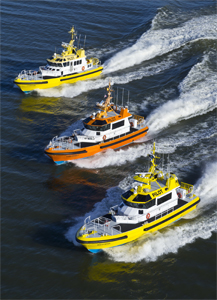 |
|
Vigor subsidiary Kvichak Marine delivered the pilot boats Chinook, top, Columbia, center, and Astoria to the Columbia River Bar Pilots in 2000, 2008 and 2014, respectively. All three were designed by Camarc Ltd. of the United Kingdom. |
|
Courtesy Vigor |
“That is a nice innovation,” Willard said. “We urged them to have trim tabs because you can’t dial in one running trim for every sea state. A modern planing hull is like a modern airplane — it needs to have trim control to get the most out of it.”
Most of the pilot boats built by Gladding-Hearn in the past 40 years have been aluminum deep-Vs. They range from about 40 feet to 75 feet, with conventional powertrains, waterjets and more recently Volvo Penta IPS propulsion. But the heart of these vessels remained more or less unchanged.
“It’s the same formula with minor variations,” Willard said. “It’s an evolution … and a constant improvement really. We have made small improvements every time as we’ve gone along.”
Other shipyards also have contributed to pilot boat design and function, including Vigor, formerly Kvichak Marine Industries in Seattle. The yard has delivered more than 20 launches since the mid-1980s, among them three groundbreaking 72-footers for the Columbia River Bar Pilots: Chinook in 2000, Columbia in 2008 and Astoria in 2014.
Vigor teamed with Camarc Ltd. of the United Kingdom for a vessel capable of speed, power and stability in some of the worst conditions anywhere. The self-righting launches feature a double-chine hull, a design that worked so well Vigor adapted it for the response boat-medium vessels built for the U.S. Coast Guard.
Art Parker, sales manager for Vigor, acknowledged that pilots are continuing to demand additional speed, in part because they need to travel farther to meet deeper-draft ships. But he also said, like Duclos at Gladding-Hearn, that the advances are incremental in nature.
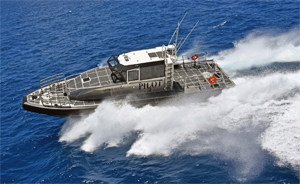 |
|
The 45-foot George Freeman, now operating for the Virgin Islands Port Authority, is one of two pilot boats Louisiana-based Metal Shark delivered in the past year. Construction was wrapping up in December on a 64-foot launch for the Brazos Pilots Association of Freeport, Texas. |
|
Courtesy Metal Shark |
“The changes are significant, but they are subtle,” Parker said. “The visibility is better, the electronics are better, but there is not really anything that is big and bold and completely different. They are the derivation of an incredibly well-proven hull form.”
In recent years, Metal Shark has sharpened its focus on pilot boats as well. The company, known for building aluminum patrol boats for law enforcement and the military, adapted its proven Defiant hull for the pilot market.
“It’s a classic deep-V design,” said Carl Wegener, Metal Shark’s vice president of commercial sales. “It’s the same hull that is on a lot of big sportfishing boats as well, and they have done a lot of big sportfishing events in very nasty seas.”
A new player in the U.S. pilot market is Baltic Workboats, an Estonia-based company that has built more than 90 pilot boats since 2000, mostly for European operators. Its first U.S. pilot boat was a 50-foot vessel delivered to the Port Everglades (Fla.) Pilots Association in 2017. At about the same time, the company bought a shipyard in Tampa, Fla., and established a U.S. subsidiary.
“As demand for our products in the Western Hemisphere continues to grow, we plan to shift the production to this new facility,” said Carl Mahler, head of sales for Baltic Workboats U.S.
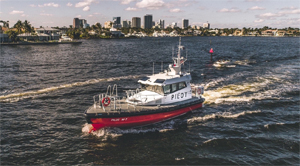 |
|
Pilot No. 7, a 50-foot newbuild for the Port Everglades (Fla.) Pilots Association, was designed and constructed by Baltic Workboats U.S., which is breaking into the North American market. |
|
Courtesy Baltic Workboats U.S. |
The Port Everglades boat, Pilot No. 7, features the company’s “wave-piercing hull” developed over three years starting in 2011. Since then, Baltic Workboats has built 32 pilot boats with this hull form designed to reduce pitching when the vessel encounters waves at high speeds.
“This allows us to create a lighter, faster hull that is more efficient and yet can still provide a more comfortable ride than a heavy traditional hull form,” Mahler said.
According to the company, “The wave-piercing bow design provides a longer waterline … when compared to a traditional-hull vessel. In rough sea conditions when the bow becomes submerged, the top surface of the bow creates increased downforce, which compensates for the buoyancy of the bow.”
Last summer, Baltic’s European arm delivered a 148-foot diesel-electric hybrid patrol vessel, and it is exploring a similar application for pilot boats.
The ever-increasing need for speed will likely remain an ongoing challenge for U.S. pilot boat builders. But it’s safe to assume that no matter what happens with propulsion, pilots will be using deep-V pilot boats for generations to come.

